This year, three diagnostic products for dermatological AI have been produced. One is the comprehensive platform for skin patient care intelligent diagnosis and treatment, which is jointly launched by Xiangya Second Hospital of Central South University (hereinafter referred to as Xiangya Second Hospital) and Lilac Garden and Ruiqi Software. On April 27th, the three parties held a clinical opening conference in Changsha Xiangya Second Hospital, which was officially opened to clinicians.
The other two dermatological AI products are the AI ​​system jointly developed by Sino-Japanese Friendship Hospital and U-Tech, and the skin patient intelligence diagnosis system based on deep learning technology jointly developed by Peking Union Medical College Hospital and Nankai University. These two products are positioned to provide convenient and quick reference and guidance for the majority of dermatologists, general practitioners, and primary dermatologists.
It can be seen that more and more companies choose to jointly develop dermatological AI assisted diagnosis and treatment systems with universities, hospitals or medical experts. So, how many skin AI projects are there in the world? What is the effect? What are the challenges? How is the policy guided? The arterial network combed this.
The evolution of artificial intelligence policy from industry to health
The development of the medical industry is closely linked to the policy. This year's dermatological AI products are frequently born, and they are inseparable from the policy guidance. According to the public information retrieval, we have listed the policies related to artificial intelligence in the past three years in China, and found that there are few policies for medical artificial intelligence alone, and most of them are applicable to the whole industry. details as follows:
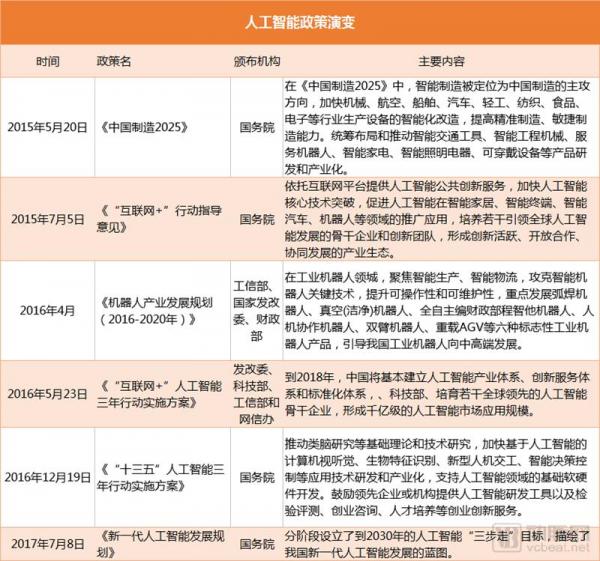
In the 2017 Medical Big Data and Artificial Intelligence Industry Report released by the Eggshell Research Institute in 2017, artificial intelligence is applied to the medical and health fields, which is beneficial to doctors, medical institutions, patients, and enterprises.
At the doctor's end, it helps doctors improve the speed and accuracy of medical diagnosis, increase the supply of doctors, detect diseases earlier, provide personalized analysis, optimize treatment plans, and reduce subsequent medical expenses;
At the patient end, the proportion of self-examination and self-management of patients is improved, the demand for doctors is reduced, and the cost is reduced;
On the medical institution side, it improves the efficiency of medical institutions and doctors, optimizes the management level of hospitals, and reduces medical costs. The enterprise side helps R&D personnel discover valuable new drugs.
Therefore, artificial intelligence was very hot last year and capital was laid out. According to the statistics of the arterial network, there were 27 financing incidents in the medical artificial intelligence industry in 2017. If several companies that did not announce the news were counted, the total financing in this field exceeded RMB 1.7 billion in 2017, and the industry leader has also entered the B round. These companies also cover a wide range of diseases, including dermatology, pulmonary nodules, and diabetes. Among them, dermatological AI products are the most.
On April 28 this year, the General Office of the State Council issued the "Opinions on Promoting the Development of "Internet + Medical Health"" (hereinafter referred to as "Opinions"). Encourage medical and medical superior medical institutions to provide remote consultation, remote ECG diagnosis, remote imaging diagnosis and other services to the grassroots level through the use of artificial intelligence and other technical means to promote real-time access and mutual recognition and sharing of inspection results between medical institutions.
Perhaps the introduction of this policy will be more conducive to the diversification of medical artificial intelligence products, and quickly enter the medical institutions, greatly promoting the development of the medical artificial intelligence industry.
Why are dermatological AI products the most?
It is reported that dermatology is a discipline that relies on morphological features. Skin imaging is an important means of diagnosing skin diseases. Skin imaging diagnosis has evolved from initial observations to magnifying glass and microscope-assisted diagnosis to digital imaging techniques and intelligent analysis in recent years.
At present, skin imaging technology represented by dermascope, skin ultrasound and skin CT has become an important tool for the diagnosis of clinical dermatological diseases. Dermatoscopy has many diagnostic methods for melanoma, including ABCD method, pattern recognition method, seven-point detection method, three-point detection method, CASH method, etc. These methods guide doctors to score the extracted features. Come, this is an example of a mature application of artificial intelligence. If you can combine the multi-dimensional skin image resource library, extract the disease characteristics of many skin diseases, and standardize the recognition, you can better teach the machine how to judge.
Stanford University published an article on Nature, using 130,000 skin disease image databases for artificial intelligence to automatically diagnose skin diseases. The image database contains dermoscopic images, cell phone photos, and standardized photos. The result is the use of artificial intelligence diagnostic systems to identify benign skin tumors, malignant tumors and other non-neoplastic skin diseases. As a result, the results of artificial intelligence diagnosis are highly consistent with the results of dermatologist diagnosis, and the diagnostic efficiency is tied.
For example, in the common and frequently-occurring diagnosis and treatment activities such as psoriasis, urticaria, and hemorrhoids, doctors' diagnosis, prescription, and health education are not only repetitive tasks, but also communicate with patients in a small space. Every day, this part or part of it may be replaced by artificial intelligence.
However, there are many kinds of diseases in dermatology, and the identification criteria and diagnostic criteria are not uniform. It is not easy to teach robots how to identify and diagnose diseases. It is one of the bottlenecks in AI diagnosis of skin diseases. At present, skin images are still difficult to realize automatic recognition and diagnosis of pathological images. In addition, there are rare diseases in skin diseases, and there are very few cases. The amount of specimens is not enough to provide machine training, and the efficiency of ideal automatic recognition diagnosis is difficult to achieve.
Summary of 11 kinds of dermatological AI products at home and abroad
To this end, we have selected domestic and foreign dermatological AI products for analysis, through the project participants, application, positioning and other dimensions analysis, I hope to understand the general situation of skin disease AI, and their product features.
According to the public information search, we found 11 kinds of dermatological AI products at home and abroad. The birth time was first in 2012, and 10 were born between 2015 and 2018. The participants included enterprises, universities, hospitals, etc. Most dermatological AI products are used on the doctor's side to provide doctors with diagnostic decisions. The specific rules are as follows:
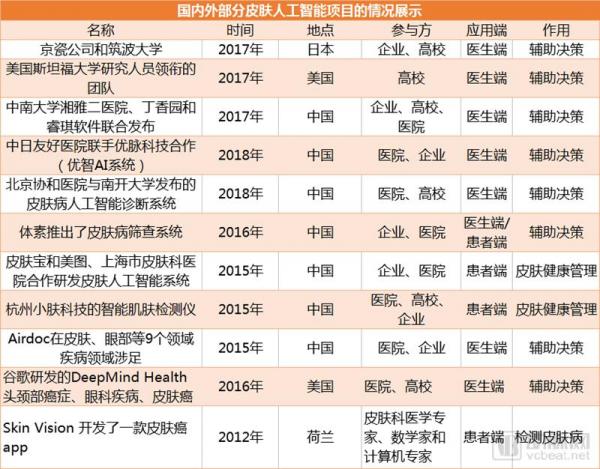
1. Time of birth of dermatological AI products: most in 2015 and 2017

From the time dimension, dermatological AI was born in 2012, and the number of products born in 2017 and 2015 was 3, and both in 2016 and 2018.
2015 is the beginning of artificial intelligence, and 2017 is called the first year of artificial intelligence. According to industry sources, at that stage, if the technology company does not mention artificial intelligence, it feels that they are not insiders. How hot was it at the time?
According to statistics from the Arterial Network in 2017, in the financing aspect, there are 27 financing incidents in the medical artificial intelligence industry. If you count several companies that have not announced the news, the total financing in this field will exceed RMB 1.7 billion in 2017, the industry leader. Has also entered the B round state.
In terms of policies, the 2017 medical artificial intelligence industry related policies are gradually advancing. According to the arterial network, since the State Council issued the "New Generation Artificial Intelligence Development Plan" on July 20, the China Inspection Institute and the CFDA are actively engaging with industry professionals, and relevant policies and regulatory programs are in full swing.
At the same time, domestic technology giants have also set foot in the market. In 2017, technology giants such as Ali, Tencent, and Keda Xunfei successively released medical artificial intelligence products, and the products were put on the hospital, and they were tested by practice. Based on artificial intelligence technology, they built a smart hospital.
Foreign well-known medical artificial intelligence big cows also returned to China in 2017 to participate in this medical AI entrepreneurial wave. Xing Lei, a professor at Stanford University, Xiong Huiyuan, co-founder of Deep Genomics, and Tao Xiaodong, the chief architect of the original Philips Medical Radiation Solutions...
In terms of landing physical medical institutions, in 2017, the number of medical institutions that each medical artificial intelligence company landed increased by more than 1,000. A dean who attended the medical conference once said that this hospital did not talk about artificial intelligence this year, and felt that it was OUT.
2. The area covered by global skin AI: China has the most products involved
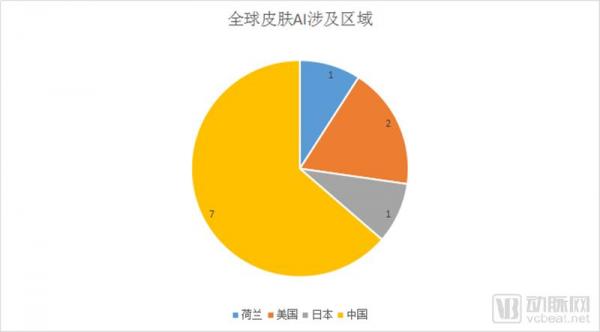
From the global area of ​​AI involving skin diseases, there are China, the Netherlands, the United States, and Japan. Among them, there are 7 kinds of dermatological AI products born in China, and there are 7 kinds. The second is the United States, and there are 2 kinds.
Because in the context of the new medical reforms implemented in China, especially in the deep-water period of medical reform, all products that can change the pain points of the medical industry and applications in foreign countries are sought after by investors and entrepreneurs. Such as mobile medical , digital medical , medical artificial intelligence, blockchain and so on.
Medical artificial intelligence has always been highly anticipated by people, and it is regarded as the fundamental way to solve medical productivity. In China, the aging of the population, the rapid growth of chronic diseases, the serious imbalance between the supply and demand of medical resources, and the uneven geographical distribution have created a huge demand for medical artificial intelligence. At the same time, China has a large population base, rich industrial portfolio, and sufficient talent reserves. It also provides a good foundation for the development of artificial intelligence.
Although the United States has been at the forefront of basic research in artificial intelligence, in the past two years, China's artificial intelligence technology talents are achieving overtaking in corners.
According to the National Artificial Intelligence Research and Development Strategy Plan published by the United States, from 2013 to 2015, the number of papers involving “deep learning†increased by about 6 times in the artificial intelligence direction papers included in SCI. The number of papers published by Chinese scholars has surpassed that of the United States since 2014 and is significantly ahead of other countries.
3. The most involved participants in the skin AI system are enterprises, hospitals, and universities.
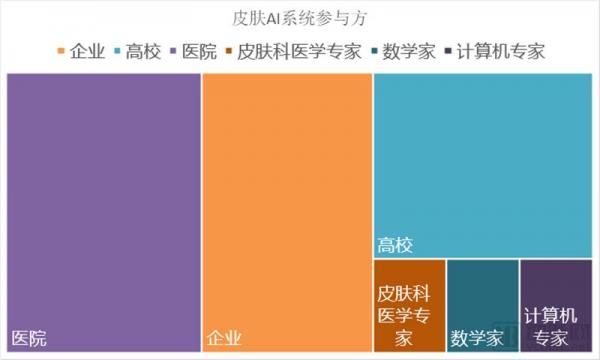
From the perspective of the participants, it involves a multi-party collaboration involving a skin disease AI. Hospitals, enterprises, universities, dermatologists, mathematicians, and computer experts have fully demonstrated the characteristics of "specialization in the industry" among various industries.
In a nutshell, a skin disease AI product is inseparable from data and technology support. In addition to computer science, artificial intelligence involves many disciplines such as information theory, cybernetics, automation, bionics, biology, psychology, mathematical logic, linguistics, medicine, and philosophy. The main contents of artificial intelligence research include: knowledge representation, automatic reasoning and search methods, machine learning and knowledge acquisition, knowledge processing system, natural language understanding, computer vision, intelligent robot, automatic programming and so on.
4, skin AI application: 63% applied to the doctor
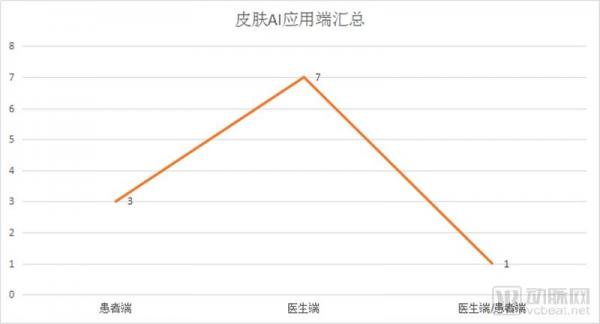
At present, dermatological AI products are applied to doctors, patients, doctors and patients. Among them, 63% of dermatological AI products are applied to doctors.
For example, in 2012, the Netherlands launched an app called SkinVision for C-end patients. It can detect 73% of melanomas using only images. It can help users track the size and shape changes of the surface blackheads, analyze whether they are likely to have malignant lesions, and remind users to maintain suspicious black spots. Pay close attention or consult a doctor.
SkinVision starts from the perspective of black cockroaches, because black cockroaches (especially those that grow abnormally) are early signs of skin cancer, and the most deadly type of skin cancer, malignant melanoma, is made up of inconspicuous blacks.ç—£ Developed. If diagnosed at an early stage and treated promptly, up to 95% of patients with skin cancer can achieve radical or long-term survival; if not discovered until later, the long-term survival rate is only 15%.
Caucasian skin is naturally lacking melanin to protect against UV rays in the sun, so the incidence of skin cancer is higher than that of both yellow and black, so a mobile application like BlackVision for blackhead self-test has a huge market in Europe and America. potential.
In 2012, SkinVision received an investment from the German investment agency Personal Health Solutions. From 2012 to November 2014, about 100,000 people have already downloaded the app and provided 175,000 photos to the product database, which will be used for further development in the future.
5, skin disease AI product positioning summary: assisted decision-making is more common
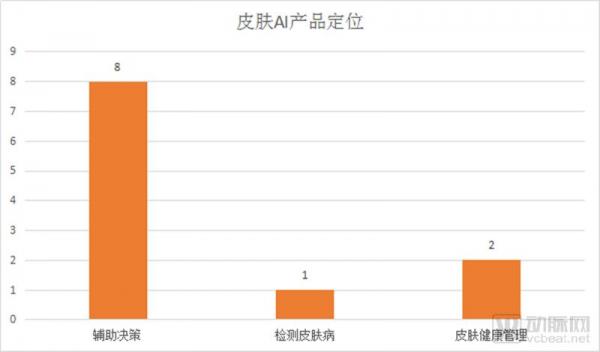
From the information collected so far, there are three types of dermatological AI positioning, which are related to the needs of users, assisted in making diagnostic decisions, detecting skin diseases, and skin health management, among which the products that assist diagnosis and decision-making are the most.
The reason for this result is that the medical industry faces the dilemma of a shortage of doctors. According to a study by The Lancet in 2017, between 2005 and 2015, 4.7 million medical students in China graduated, while the total number of doctors increased by only 750,000.
The author of this study was Professor Fan Peijun from National Yangming University in Taiwan. The study was combined with the report of the National Health and Family Planning Commission and Peking Union Medical College Hospital and the yearbook analysis. From the beginning of 2005 to the end of 2014, the graduates of medical undergraduate education was 4374191, seven years. The graduates were 4,131,865, and a total of 4.72 million medical students graduated, while the number of new practitioners during this period was only 750,000.
Among them, the proportion of clinicians aged 25-34 decreased from 31.3% to 22.6%, and the proportion of physicians aged 60 and over rose from 2.5% to 11.6%. The proportion of seven-year graduate students 4.3% rose to 11.2%. The gap in doctors in rural areas is over 500,000. This is precisely the weakest place in China's medical level, and it is also the most supportive policy, and advocates the development of primary health care. Perhaps the emergence of medical artificial intelligence will change this situation.
So what are the specific applications of these dermatological AI products? To this end, we have selected two products with typical significance, one is the intelligent skin-assisted diagnosis and treatment system developed by enterprises and hospitals; the other is the diagnosis system jointly developed by universities and hospitals.
Case 1: Xiangya Second Hospital, Lilac Garden, and Ruiqi Sanfang released AI auxiliary diagnosis and treatment system for skin diseases
In fact, in May last year, Xiangya Second Hospital, Lilac Garden and Ruiqi Software jointly released China's first skin patient intelligence intelligent diagnosis and treatment system - smart skin. In one year, after many tests, audits, and trainings, and the cumulative study of more than 600,000 cases, the smart skin has recently achieved a major breakthrough: 86% of the 85 skin disease recognition accuracy, including 34 Common diseases are greater than 95%, and the number and accuracy of identifiable diseases rank first in the industry.
Among the three parties involved in the cooperation, the data is provided by Xiangya Second Hospital, which combines the massive image resources of more than 20 top three hospitals across the country; the technology is the core algorithm architecture based on the “shape†of Ruiqi Software. "Shaping" is Ruiqi's powerful image recognition system, which is in the leading position in the industry. Clove Garden is good at integrating and coordinating medical industry resources and participating in the design, development and operation of the system.
From April 16th to 25th, Xiangya Second Hospital and Lilac Garden jointly launched “Assisting AI†– the whole network of dermatologists qualifying.
Among all the 545 dermatologists/sexologists participating in the competition, the doctors at the higher level and above were significantly better than the other doctors in average scores and participation enthusiasm. The average answer score was 69.03 points and the average completion time was 107 seconds. The average score for smart skin is 87.5 points and the average completion time is 31.4 seconds.
As a result, Professor Lu Qiang, director of the Department of Dermatology and the doctoral supervisor of the Second Xiangya Hospital of Central South University, was not surprised. He said that in the specific case where doctors and AI systems are looking at pictures, the accuracy and time of artificial intelligence is higher than that of doctors, mainly because the machine learns a lot of pictures.
According to him, the application of smart skin has been rolled out in primary health care institutions. In April 2018, "Smart Skin" entered the People's Hospital of Jianghua Yao Autonomous County in Hunan Province and the People's Hospital of Pengyang County in Ningxia Guyuan, providing advanced artificial intelligence-assisted diagnostic technology for the grassroots doctors, connecting the top dermatological diagnosis and treatment resources of the country, and carrying out the precision medical poverty alleviation plan. .
Gao Yong, from Pengyang County People's Hospital in Ningxia, said, “There is no professional dermatologist in our hospital, which is operated by a surgeon. Therefore, the diagnosis of the skin patient who came to see the doctor is in a state of ambiguity, and the treatment plan is naturally blurred. After the smart skin, as long as the doctor takes a picture of the patient's lesion, according to the doctor's own experience, select the most similar disease, and the system gives a conclusion. The time is very short, which greatly improves the doctor's diagnosis speed and Level. I hope that the platform can be promoted to a more impoverished and more remote place, so that patients with skin diseases can receive more precise treatment and consolidate the level of diagnosis and treatment of primary care."
At the press conference held on April 27th, the Skin Patient Intelligence Development Alliance was officially established at the same time. Professor Lu Qiang is the chairman of the alliance, and Mr. Zhang Wei, vice president of Clove Park, serves as the secretary general of the alliance. Alliance members from all over the country will gather power to expand the intelligent system to more diseases, and also make the system platform more comprehensive.
In order to let the whole medical poverty alleviation work be implemented and carried out in depth, the three parties also prepared a complete set of comprehensive support resources for the support unit. The specific plan is as follows:
1 year of use of the skin patient's intelligent auxiliary diagnosis and treatment integrated platform;
1 LCD monitor, 1 cloud set-top box and 2 smart phones;
200 dermatologists remote consultation and case discussion opportunities;
100 dermatology professional study courses;
Provide training and training opportunities for members of the Skin Patient Intelligence Development Alliance;
Lilac Internet Hospital is stationed and invited for medical treatment.
These programs will be officially launched into the first batch of precision medical poverty alleviation units, including Pengyang County People's Hospital, Pingjiang County First People's Hospital, Pingjiang County Hospital, Anhua County People's Hospital, Yanling County People's Hospital, and Cili County. Chinese Medicine Hospital, Guidong County People's Hospital, Jianghua Yao Autonomous County People's Hospital, Yucheng County Leather Defense Institute, Xintian County People's Hospital.
As a platform operator, when asked when to open to patients, Zhang Wei, vice president of Lilac Park, said that in the short term, the platform will not be open to patients for direct diagnosis of the disease. Under this premise, the platform-oriented patient service is based on the overall disease information submitted by the patient for intelligent triage, and after the comprehensive geographical factors and disease factors, help the patient to match the appropriate medical institution. This is consistent with the country's strategic direction of deepening graded diagnosis and treatment.
When talking about the future planning of the Skin Patient Intelligence Development Alliance, Professor Lu Qiang said:
In the next five years, the alliance will develop in three phases. As the first stage in 2018, we will establish a sound alliance framework and development mechanism to build a reliable comprehensive diagnosis and treatment platform; as a system development stage from 2019 to 2020, we will realize coverage of major skin diseases and establish a field of skin patient intelligence. Industry standard; 2021-2023 is the ecological improvement stage, forming a complete value chain of production, education and research.
Case 2: Skin Patient Intelligence Diagnostic System issued by Peking Union Medical College Hospital and Nankai University
On March 30, 2018, Peking Union Medical College Hospital of Chinese Academy of Medical Sciences and Nankai University jointly released a skin patient intelligence diagnosis system based on deep learning technology. It is called a mobile phone to capture a disease, similar to the SkinVision product, but the user is different. SkinVision is for patients with C-ends, and the dermatological AI they developed is for doctors.
The technology was developed by the Yang Jufeng team of the Computer Vision Laboratory of the School of Computer and Control Engineering, Nankai University, and the Peking Union Medical College Hospital. It consists of two main functions. One is to use the dermabrasion to photograph the skin pigmentation and to identify the dermoscopic image; It uses an ordinary mobile phone to take images of skin lesions and intelligently identify skin lesions to provide a diagnostic reference for common skin diseases.
At present, the recognition accuracy of the system for pigmented skin imperfections has reached more than 92%, providing a good diagnostic basis for the early detection of melanoma. At the same time, the accuracy of several common skin diseases (such as eczema, psoriasis, and pityriasis rosea) in the skin lesions captured by mobile phones has reached more than 80%.
In addition to assisting general practitioners and primary dermatologists in diagnosing disease, the system opens up another innovative way to alleviate the serious lack of dermatologists and the patient's medical difficulties in remote and poor areas. This system will connect the medical poverty alleviation projects in the three provinces of Heilongjiang, Shanxi and Jiangxi this year to help grassroots doctors in poor areas to better and more confidently face and deal with dermatological diseases, and to improve the quality of life of people in poverty-stricken areas. contribution.
It is understood that the Computer Vision Laboratory of the School of Computer and Control Engineering of Nankai University actively responds to the national call, aiming at the forefront of international artificial intelligence research, and is committed to applying machine learning technology to practical problems of computer vision, and with the University of California, Cardiff, UK The university and Peking Union Medical College Hospital have established close cooperative relations. The dermatological intelligent diagnosis system that participated in the development is based on the long-term theoretical research and accumulation of the laboratory. The preliminary results have been published at the International Conference on Computer Vision (ECCV) and the International Conference on Computer Vision and Pattern Recognition (CVPR). on. Related work has promoted the transformation of computer vision, artificial intelligence and other technologies in the field of intelligent medicine, providing convenient and rapid reference and guidance for the majority of dermatological patients, general practitioners, and primary dermatologists, and achieving greater social value.
Future application of cutaneous AI is mixed
Domestic dermatological AI products and pilot hospitals have already been established, and foreign AI diagnostic systems have been approved in succession. This is worthy of “his†entrepreneurs.
Since the establishment of the AI ​​and Digital Medical Review Department by the FDA in 2017, AI medical products have received strong support from the FDA. In the short period of 3 months after entering 2018, a number of AI diagnostic decision support systems have been approved successively. This is unprecedented in the history of FDA, and the trend of medical AI in the future is already very obvious. It not only includes the current hot image recognition, but also includes methods such as image grouping to integrate image information with clinical information for overall calculation.
At present, AI medical products are FDA-approved products in the world. From the perspective of diseases, there are stroke, atrial fibrillation, heart disease, lung disease, liver disease, children with autism, diabetic retinopathy, lung cancer, breast cancer, rectal cancer, colon cancer. , gastric cancer and cervical cancer, pneumonia, Alzheimer's disease, congenital cataract, skin cancer, etc.
The worry is that China has not yet obtained a new generation of AI medical products certified by the Food and Drug Administration. As a result, the product cannot be quickly circulated in the market through the hospital procurement model. How to do?
The regulatory authorities are also actively studying the approval mechanism for medical artificial intelligence products. On September 4, 2017, the CFDA released a new edition of the Catalogue of Medical Devices, adding a category corresponding to AI-assisted diagnosis.
According to the latest classification regulations, if the diagnostic software provides diagnostic advice through an algorithm, only the auxiliary diagnostic function, and does not directly give a diagnosis conclusion, the second type of medical device is declared. If the lesion is automatically identified and a clear diagnosis prompt is provided, Then according to the third category of medical device management.
It is worth noting that the third type of medical equipment needs to be clinically tested, the second type of equipment has a clinical trial exemption list, and the diagnostic software declaration can be exempted. The CFDA has not yet made specific specifications.
The specification will be implemented on August 1, 2018. If each medical artificial intelligence company wants to take the hospital procurement route, then obtaining the certification of the Food and Drug Administration is the only way to authenticate the three types of medical devices, or to diagnose The software is not exempt, so a lot of real clinical application data will be of great help to the company's application.
In addition, the Chinese procuratorate is also formulating approval rules. At present, the team of fundus image calibration experts has been established, and the approval criteria for lung nodules are also being formulated. AI will bring profound changes to future medical technology and is a powerful driving force for future medical innovation and reform.
The flower type surgical lamp is designed at 2016, when it was been pushed into the market, it has good echo from the customers, because the flower type surgical lamp outlook is different with normal round types lamps, its outlook is just like a flower, it is very beautiful , also can add beauty in the operation room, the flower type ot lamp change the normal condition for baldness operation room style, can make doctor and patients feel much difference; for the flower type surgery lamps specification, it is almost same as round type surgical lamp, in the first year, it also has good selling;
Flower type surgical lamp also has three types, ceiling types which include single dome, double dome , with camera or without camera; wall type and mobile type flower operation lamp;
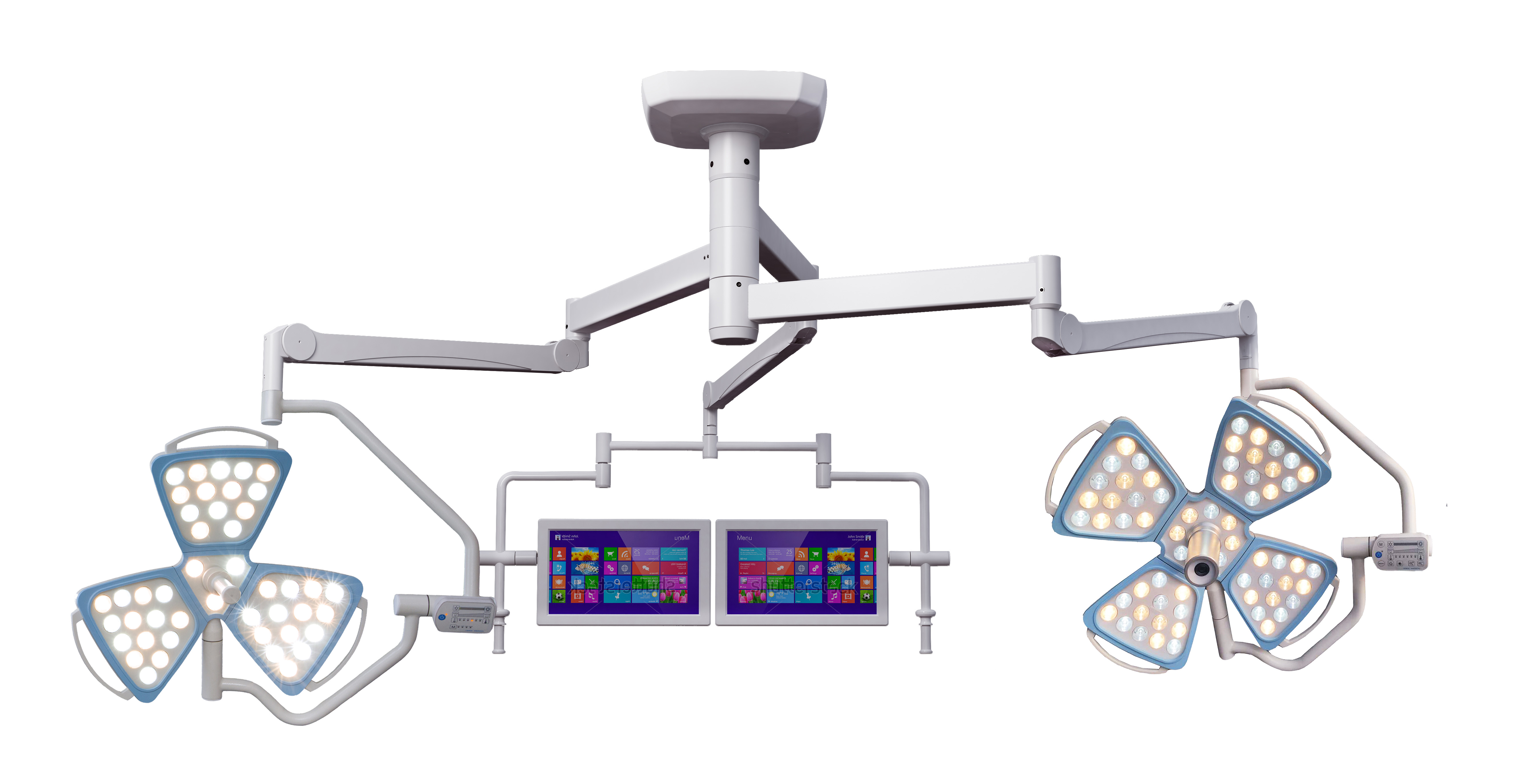

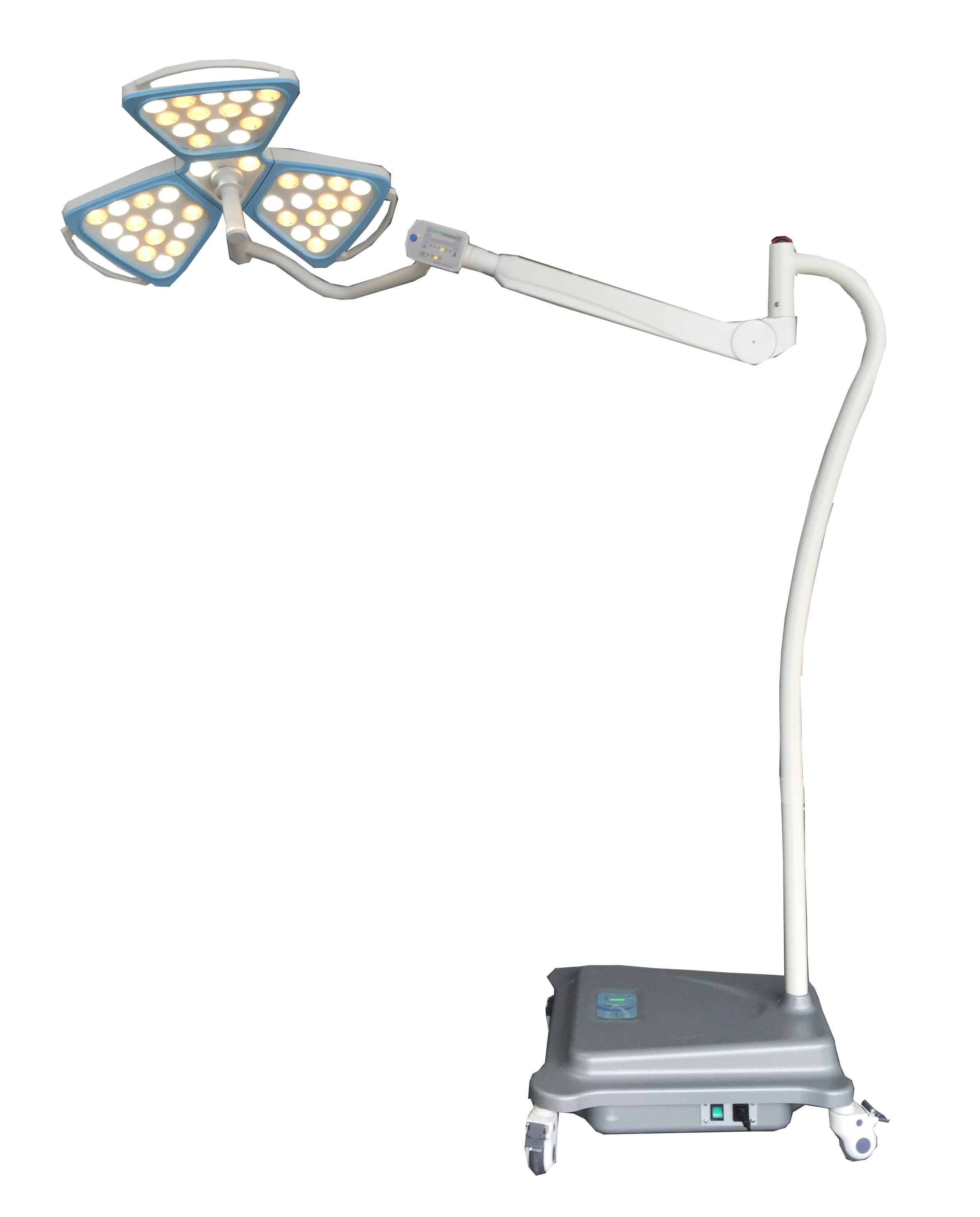
ot light,operation theatre light,operating light,operating room light,surgery light,surgicai lamp,Led ot light
Shandong Lewin Medical Equipment Co., Ltd. , https://www.lewinmed.com